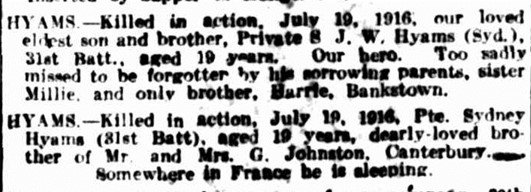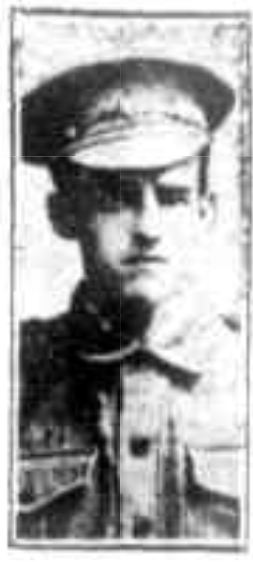
Sydney Joseph Walter HYAMS
Eyes grey, Hair dark brown, Complexion dark
Sydney Hyams - “Somewhere in France He is Sleeping”
Can you help us identify Sydney?
Sydney was killed in Action at Fromelles. As part of the 31st Battalion he was positioned near where the Germans collected soldiers who were later buried at Pheasant Wood. There is a chance he might be identified, but we need help. We are still searching for suitable family DNA donors.
In 2008 a mass grave was found at Fromelles, a grave the Germans dug for 250 (Australian) bodies they recovered after the battle.
If you know anything of contacts here in Australia or his relatives from Russia or Lithuania, please contact the Fromelles Association.
See the DNA box at the end of the story for what we do know about his family.
We would like to thank FAA researchers Peter Allen, Rosemary and Eric Kopittke for their extensive genetic research, particularly in Europe.
Syd’s Early Life
Sydney Joseph Walter Hyams was born in 1896 in Paddington, Sydney, New South Wales. He was the second of Joseph and Ellen Elizabeth (nee Gouge) Hyams’ four children. Joseph and Ellen had married in 1891 in Victoria. Syd’s elder sister Ester Elizabeth (Essie) was born in 1892 in Avoca, Victoria, before the family moved to Sydney in 1895. Harrie (b 1899) and Millie (b 1901) were born in Sydney where Joseph worked as a clothier, a canvasser and an agent.
Joseph had immigrated to Australia from England, arriving on 24 February 1879 in Melbourne on the Garonne. While Joseph listed his nationality as English on his arrival into Australia, when he was naturalised as a citizen in 1904, he stated he was born in Dorbian, Co Kovina, Russia, which is now in Lithuania. Syd attended the Paddington Superior Public school and later was working as a labourer at the time he enlisted.
Off to War
Syd enlisted on 9 November at Casula NSW, west of Sydney. He was assigned to the 3rd Reinforcements for the 31st Battalion. At this time the original enlistees for the 31st had just completed their introductory training and were about to depart from Australia for the camps in Egypt. At their departure, the Minister for Defence, H.F. Pearce, said, “I do not think I have ever seen a finer body of men.”
Source INFANTRY MARCH PAST (1915, November 6). Weekly Times (Melbourne, Vic. : 1869 - 1954), p. 32. http://nla.gov.au/nla.news-article132708935
Syd’s 3rd Reinforcements soldiers departed Australia on 18 February 1916 aboard HMAT A70 Ballarat , disembarking in Suez, Egypt on 23 March 1916. After heading to the camp at Duntroon Plateau, Syd joined the full 31st Battalion and was assigned to B Company. While Syd had a bit less time in Egypt than the original enlistees, by the time the 31st Battalion was transferred to France, the men were all heartily sick of the “100 degree heat in the shade” and sand in Egypt.
On 15 June, the 31st Battalion began to make their way to the Western Front, first by train from Moascar to Alexandria and then aboard the troopship Hororata sailing to Marseilles. After disembarking on 23 June, they took trains to Steenbeque and marched to Morbecque, 35 km from Fleurbaix, arriving on 26 June. The battalion strength was 1019 soldiers.
The Battle of Fromelles
Training continued, with how to handle poisonous gas now being included in their regimen. They began their move towards Fleurbaix on 8 July and by 11 July they were into the trenches for the first time, relieving the 15th Battalion. They were then relieved by the 4th NZ on the 16th.

An attack on the German trenches was planned for 17 July, but bad weather caused it to be postponed. On the 19th they were back into the trenches and were in position at 4.00 PM:
“Just prior to launching the attack, the enemy bombardment was hellish, and it seemed as if they knew accurately the time set.”
The assault began at 5.58 PM and they went forward in four waves, A and C Company in the first two waves and Syd’s B Company and D Company in the 3rd and 4th waves. While the pre-battle bombardment did have a big impact, the soldiers were still under heavy artillery, machine gun and rifle fire and by 6.30 PM the Aussies were in control of the German’s 1st line system (Trench B in the diagram below). It was described as “practically a ditch with from 1 to 2 feet of mud and slush at the bottom”. Source AWM4 23/49/12, 32nd Battalion War Diaries, July 1916, page 11

This allowed them to link up with the other battalions and occupy a line from Rouges Bancs to a position near Delangre Farm. Unfortunately, with the speed of their attack, ‘friendly’ artillery fire caused a large number of casualties. Based on input from Syd’s mates, it was around this time and place that he was killed.
Private Herbert James Hudson (453) stated that at around 7.00 PM Syd was alongside of him, 400 yards beyond the first line of German trenches, when a shell landed nearby hitting Syd in the back and groin, killing another soldier and knocking Private Hudson away. Hudson then saw Syd drop forward, face down as though he were dead. Sadly, the urgency of the situation required Herbert to have to leave Syd and move on.
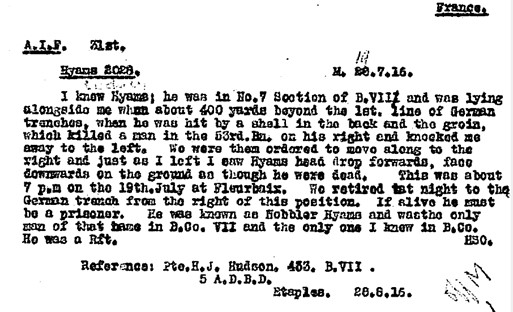
The battle raged on and the Aussies were told that “the trenches were to be held at all costs”.
Source AWM4 23/49/12, 32nd Battalion War Diaries, July 1916, page 12
The Australians made a further charge at the main German line beyond Trench B, but they were low on grenades, there was machine gun fire from behind from the emplacement at Delangre Farm and they were so far advanced that they were getting shelled by both sides. At 4.00 AM the Germans began an attack from the Australian’s left flank, bombing and advancing into Trench A (map).
Given the Australian advances that had been made earlier, portions of the rear Trench E had been left almost empty, which then enabled the Germans to be in a position to surround the soldiers. At 5.30 AM the Germans attacked from both flanks in force and with bombing parties. Having only a few grenades left, the only resistance the 31st could offer was with rifles.
”The enemy swarmed in and the retirement across No Mans’ Land resembled shambles, the enemy artillery and machine guns doing deadly damage.”
The 31st were out of the trenches by the end of the day on the 20th. From the 1019 soldiers who left Egypt, the initial impact was assessed as 72 soldiers killed, 581 wounded and 85 missing. To get some perspective of the battle, when Charles Bean, Australia’s official war historian, attended the battlefield two and half years later, he observed a large amount of bones, torn uniforms and Australian kit still on the battlefield.
The ultimate total was that 161 soldiers from the 31st were either killed or died from wounds and of this total 82 were missing/unidentified. To date (2024), 23 of those missing have been later identified and are properly buried in the Pheasant Wood Cemetery. The bravery of the soldiers of the 31st was well recognised by their own Battalion commanders.
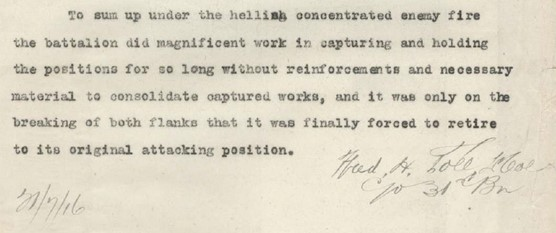
After the Battle
Syd was recorded as missing by his battalion. He began to appear in communications received from the Germans dated the end of November, so they had recovered his body from the battlefield. These reflect a message dated 2 August 1916 that Syd had “fallen in the neighbourhood of Fromelles”, and he was on a German Death List of 4 November.
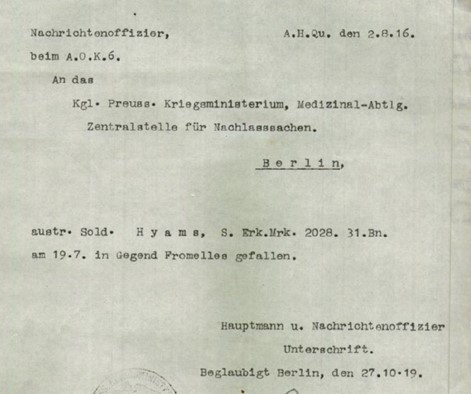
While documentation was being kept by the Germans and the Australians, the information flow to home was slow. The Red Cross had advised Syd’s mother Ellen that he was had been seen in the battle and was missing, but they had little else to offer. In a letter dated 28 November 1916 she remained hopeful, not yet ready to believe he had been killed:
'”It is now over four months since he [Private Hyams] was amongst the missing and I can get no news of him.”
“Could he possibly be amongst the French soldiers in a French Hospital [?]”
“I am very anxious to hear of him as I do not believe he has been killed.”
The Base Officer promptly replied, but noted that he had no further information to offer.
Further details unfolded, such as personal identification marks and his ID tag. Syd was formally declared as Killed in Action in a communication on 27 March 1917.
While the witness statements and the Germans’ reports all seems to fit together that Syd’s body was recovered by the Germans, there is a handwritten note at the bottom of form B.103 that states, “buried in the vicinity of Fleurbaix, Sh[eet] 36 NW.” Such annotation is on a number of other soldiers’ files, however.

Memorials
Syd was obviously loved by his family. Each of Syd’s mother, father and sister had individually contacted the Army and the Red Cross at some stage, seeking closure from anything that could be offered. The most poignant memorial statement is – “Somewhere in France he is sleeping,”
Even until 1933 his family were posting memorial notices on the anniversary of his death:
HYAMS — In loving memory of our dear brother, Syd, killed in action July 19, 1916, aged 19 years, eldest loved son of the late Joseph and Ellen Hyams, of Bankstown, N.S.W.
Inserted by E. H. and M.
Syd was awarded the Victory Medal, British War Medal, Memorial Scroll and a Memorial Plaque.
He is commemorated at:
- VC Corner, Panel 3, Fromelles, France
- The Australian War Memorial Canberra, Panel 102.
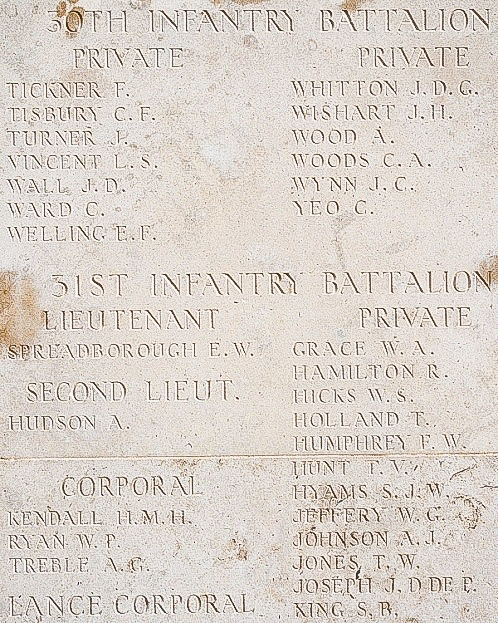
Can Syd still be found?
Syd was in the advanced lines, his body was recovered by the Germans and 23 of the 82 unidentified soldiers from the 31st Battalion have been found to be in the German’s Pheasant Wood grave. He could be one of the remaining 70 unidentified soldiers from the grave (as of 2024). We need DNA donors to be able to know.
Although Sydney listed his religion as Church of England, delving into his Russian Jewish ancestors is where the male YDNA is likely to be found. There are no known male relatives in Australia. The female mtDNA links may be able to be found through Syd’s mother Ellen here in Australia. We are most grateful for any contacts.
DNA samples are being sought for family connections to
| Soldier | Sydney Joseph Walter Hyams (1896-1916) |
| Parents | Joseph Hyams (1855-1932) b Dorbian, Co Kovina, Russia, now Klaipeda area in Lithuania, d Bankstown NSW and Ellen Elizabeth Julia Gouge (1872-1923) b Avoca, Victoria, d Sydney NSW |
| Siblings | Esther Elizabeth Hyams (1892-1964) d Marrickville NSW married George Walter Henry Johnston | ||
| Harry Victor Robert Hyams (1899-1960) d Brisbane married Ruth Lawrence (1898-1997) b Queensland, m in Kiama District, d Brisbane, Queensland | |||
| Mildred Ethel Hyams (1902-1960) b Sydney d Campsie District. She did not marry |
| Grandparents | ||||
| Paternal | Solomon (Saziah) Hyams (abt 1835) Russia or Germany and Esther Harris? | |||
| Maternal | John Hector Gouge and Elizabeth Golder |
Note. Harry Victor Robert Hyams 1899-1960 d Brisbane married Ruth LAWRENCE (no issue). Millie did not marry
The Fromelles Association would love to hear from you

Contacts
(Contact: carla@fromelles.info or geoffrey@fromelles.info).
(Contact: army.uwc@defence.gov.au or phone 1800 019 090).
Donations
If you are able, please contribute to the upkeep of this resource.
(Contact: bill@fromelles.info ).

